|
|
|
Sort Order |
|
|
|
Items / Page
|
|
|
|
|
|
|
| Srl | Item |
| 1 |
ID:
177357


|
|
|
|
|
| Summary/Abstract |
Energy efficiency policies often involve low-interest loans for retrofit measures in private buildings; the main target of these loans are meant to be households with otherwise poor access to capital. However, such programs can only be successful if the targeted households also take up these loans. This paper studies the relation between access to capital and debt aversion and the adoption of retrofit measures in European Union countries, employing a demographically representative household survey including about 6600 homeowners in France, Germany, Italy, Poland, Romania, Spain, Sweden, and the United Kingdom. The findings suggest that debt aversion negatively affects the adoption of retrofit measures by homeowners. In particular, debt-averse homeowners with poor access to capital are less likely to have adopted retrofit measures than non-debt-averse homeowners with poor access to capital. The findings further provide evidence that low-interest loan programs should be targeted at younger homeowners with lower income and less formal education.
|
|
|
|
|
|
|
|
|
|
|
|
|
|
|
|
| 2 |
ID:
177330


|
|
|
|
|
| Summary/Abstract |
Reliable and secure operation of a power system depends on the ability of system operation to address system imbalances on account of demand-supply imbalances and that an account of change in availability of transmission network elements. The impact of a power plant or transmission line failures causes a short-term imbalance between generation and demand, and balance can be addressed by deploying flexible reserves and ancillary services. The system imbalances in the Indian power system operation are addressed through Deviation Settlement Mechanism, a commercial mechanism based on a frequency linked incentive/penalty structure. Implementation of reserve regulation ancillary services in India has further helped to address deviation in frequency, congestion, and to bring grid resilience. This paper discusses the development of ancillary services in India, alongside crucial developments in the power market. Given the ongoing developments in the Indian power market and international experiences, this paper suggests a road map for further development of the ancillary services market in the country. The Indian power system has also witnessed a significant growth of variable renewable energy resources. In the future, renewable resources are expected to provide full range ancillary services ensuring the least cost, supply security, and high availability of reserves. Deviations on account of uncertainty associated with renewable resource generation are also subject to Deviation Settlement Mechanism, although with lenient penalties.
|
|
|
|
|
|
|
|
|
|
|
|
|
|
|
|
| 3 |
ID:
177366
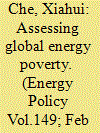

|
|
|
|
|
| Summary/Abstract |
This study makes a comprehensive assessment of global energy poverty with an integrated approach. We generate an indicator system and assign weights by rough set and a large-scale survey. Absolute ideal solutions and virtual negative ideal solutions are used to improve the Technique for Order Preference by Similarity to an Ideal Solution (TOPSIS). We further present a global assessment of energy poverty with 125 countries. The results reveal that global energy poverty improves over time. However, large spatiotemporal variations on energy poverty alleviation are found across countries. Energy availability and affordability are the major obstacles to alleviating energy poverty. Moreover, energy poverty is mostly consistent with economical levels. Developed countries have lower energy poverty than developing countries. Compared with existing methods, the proposed integrated approach can improve the accuracy of energy poverty assessment. The insights obtained from this study can help policymakers in crafting well-informed decisions and sound public policies.
|
|
|
|
|
|
|
|
|
|
|
|
|
|
|
|
| 4 |
ID:
177372


|
|
|
|
|
| Summary/Abstract |
This paper empirically examines the relative effectiveness of total foreign aid and foreign energy aid inflows on CO2 emissions in India over the period of 1978-2014 by endogenising economic growth, energy consumption, globalisation, FDI and remittances inflows as additional factors in a carbon emissions function. The results emanating from the ARDL bounds test provides evidence of a significant long-run relationship among the variables. Interestingly, it is observed that the foreign aid inflows, globalisation, and energy consumption significantly reduce CO2 emissions, whereas foreign energy aid inflows, economic growth, FDI and remittances inflows induce it. From a climate mitigation policy perspective, the results suggest that the Indian government can focus more on receiving the inflow of total foreign aid than foreign energy aid to improve the environmental quality. Given the potentiality of total foreign aid in driving the quality of the environment in India, it may be argued that much more utilisation of total foreign aid needs to be directed towards long-run investment on environmental sustainability enhancing-driven clean energy projects for an emerging economy like India.
|
|
|
|
|
|
|
|
|
|
|
|
|
|
|
|
| 5 |
ID:
177324


|
|
|
|
|
| Summary/Abstract |
Understanding competition in electricity markets is fundamental to developing good regulatory, market design and associated policy frameworks for the electricity sector. Where and when competition is effective, appropriate market designs can be largely left to run; where it is not, interventions may be needed. Despite the need to monitor competition in electricity markets, there appears to be a gap in the current literature around the competitiveness of the Australian National Electricity Market (NEM). This means that policymakers and researchers may not have enough information to adequately address the policy needs of Australia's electricity sector.
|
|
|
|
|
|
|
|
|
|
|
|
|
|
|
|
| 6 |
ID:
177345
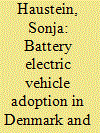

|
|
|
|
|
| Summary/Abstract |
Countries worldwide are trying to increase the share of battery electric vehicles (BEVs) to reach environmental goals. As part of these efforts, the EU project GREAT installed new fast chargers in Denmark and Sweden and provided possibilities to test BEVs and inform about them. To monitor changes in attitudes and behaviours and to estimate the impact of project activities, surveys with BEV and conventional car users were conducted in 2017, 2018, and 2019. We found that attitudes and driving behaviour of BEV users and non-users remained quite stable. While car users in Denmark and Sweden showed similar profiles, one exception was a more negative evaluation of and higher uncertainty about political support for BEVs by Danes. Modelling purchase intention, we found a significant effect of the new fast chargers in Denmark but not in Sweden, while the opposite was the case for information campaigns. Lifestyle compatibility and symbolic-affective attitudes were relevant for BEV adoption in both countries. For cross-border trips, the most relevant factor was whether people had a Tesla or not, reflecting the better driving range and fast charging infrastructure. An increase of charging infrastructure, clearer policy signals and symbolic-affective marketing are discussed as ways to increase BEV adoption.
|
|
|
|
|
|
|
|
|
|
|
|
|
|
|
|
| 7 |
ID:
177388


|
|
|
|
|
| Summary/Abstract |
Scenarios are commonly used to evaluate the environmental implications of future alternative energy pathways - they provide a benchmark for policy-makers to evaluate social, economic or environmental tradeoffs of various policies and their benefits to society. However, scenarios may leave policy-makers incognizant of potential technological hurdles, economic costs, or unforeseen environmental consequences of energy pathways, prior to venturing into long-term, binding decisions. Herein, we present a framework to bridge global socioeconomic scenarios with in situ energy policy assumptions to ensure technological alternatives can be evaluated and compared relative to realistic techno-economic constraints, environmental tradeoffs, and potential vulnerabilities arising from climate stress. We integrate downscaled Shared Socioeconomic Pathways (SSPs) with prospective Life Cycle Assessment as a framework to understand the technical specifications, i.e. raw materials, energy inputs, and environmental impacts, of alternative energy policy assumptions. We apply our integrated framework to understand the technological implications, particularly greenhouse gas emissions and water consumption, of future energy policies surrounding the practice of hydraulic fracturing in Texas, and the implications of potential adaptive responses to climate change. Results indicated that trade-offs between water conservation and greenhouse gas mitigation are inherent to hydraulic fracturing processes, necessitating careful consideration of technology options to balance environmental objectives.
|
|
|
|
|
|
|
|
|
|
|
|
|
|
|
|
| 8 |
ID:
177349


|
|
|
|
|
| Summary/Abstract |
Whether China could meet its 2030 energy conservation and emission reduction goals depends on whether energy efficiency serves as the most important measure of carbon emission reduction. This study has explored how industrial sector could achieve the goals on the premise of maintaining certain economic growth from the perspective of energy efficiency enhancement. The industrial correlation model and multi-objective optimization model are combined to find out the path of energy efficiency improvement, with the decision variables being economic output and energy intensity of various sub-sectors. Through intelligent optimization algorithm, nine paths of energy efficiency improvement are obtained and the corresponding optimal path is found out. The results indicate that regardless of the expected high-speed or medium-speed economic growth, the optimized path could achieve the goal of carbon emission peak, mainly depends on energy efficiency improvement. In the scenario of high-speed economic growth, the amount of CO2 emission could be reduced by 58.31% through energy efficiency enhancement, and further reduced by 28.22% through industrial restructuring; while in the medium-speed growth scenario, the CO2 emission amount could be reduced by 57.88% employing improving energy efficiency, and further be reduced by 29.44% employing industrial restructuring.
|
|
|
|
|
|
|
|
|
|
|
|
|
|
|
|
| 9 |
ID:
177325


|
|
|
|
|
| Summary/Abstract |
We model the evolution of the Central Western Europe power system until 2040 with an increasing carbon price and strong growth of variable renewable energy sources (vRES) for four electricity market designs: the current energy-only market, a reformed energy-only market, both also with the addition of a capacity market. Each design is modelled for two decarbonisation pathways: one targeting net-zero emissions by 2040 for a 2 °C warming limit, and the other targeting −850 Mt CO₂ y‾ for a 1.5 °C warming limit. We compare these scenarios against the high-level objectives of delivering low-carbon electricity reliably to consumers at the lowest possible cost. Our results suggest that both 2 °C and 1.5 °C compliant systems could be achieved and deliver electricity reliably. In terms of cost, we find the 1.5 °C warming scenarios lead to system costs which are twice as high as the 2 °C scenarios due to the high cost of negative emission technologies – in particular direct air carbon capture (DAC). To make a 1.5 °C target more affordable, policymakers should investigate lower cost alternatives in other sectors, and increase research and development in DAC to reduce its cost.
|
|
|
|
|
|
|
|
|
|
|
|
|
|
|
|
| 10 |
ID:
177355


|
|
|
|
|
| Summary/Abstract |
The development of renewables has attracted abundant attentions. However, existing studies have not recognized the potential impetus of Information and Communication Technologies (ICTs) on renewables. In this study, we explore the impact of mobile ICTs on renewable energy generations in seven countries including USA, Canada, UK, Germany, Italy, Netherlands and Poland. As revealed by static and dynamic empirical analyses of 19-year data, there exists significantly positive relationship between the renewables and ICTs at the macro-level. One percent increase of ICTs would lead to 0.2/1.1% increase for renewables in the long/short terms. Thus, ICTs can promote the development of renewables, and policy makers should consider full integration strategies between renewables and ICTs. Besides ICTs, factors positively affecting renewables include economic developments (long/short term), primary energy consumptions and carbon reductions (short term), and population growth (long term). Interestingly, natural gas competes with renewables in the short term, while it compliments renewables in the long term.
|
|
|
|
|
|
|
|
|
|
|
|
|
|
|
|
| 11 |
ID:
177364


|
|
|
|
|
| Summary/Abstract |
Carbon policies differentiated according to regional disparities have been recognized and recommended. However, the air quality co-benefits of differentiated policies remain unclear. Here we combine a multi-regional dynamic computable general equilibrium (CGE) model and an extend response surface model (ERSM) to investigate the impact of nationally uniform and subnationally differentiated carbon pricing policies on fine particulate matter (PM2.5) concentrations in China. All policies examined lead to the same accumulated national CO2 emissions (2020–2050), with the 2030 emissions attaining China's national abatement target. We find that, when subnational policies differentiated according to provincial PM2.5 concentrations are implemented, the higher-than-average carbon price over more polluted provinces results in twice as much reduction in CO2 and air pollutant emissions in 2050 as the national policy. As a result, the subnational policies cause larger PM2.5 concentration reductions in these provinces (9%–18%) than the national policy (7%–11%). Also, the subnational policies eliminate high PM2.5 exposure of over 45 μg/m3 which 12% people suffer from under the national policy. The subnational policies substantially reduce regional disparity in PM2.5 pollution and hence improve environmental equity. The results suggest that subnationally differentiated carbon policies are a promising instrument to mitigate severe pollution and promote environmental equity.
|
|
|
|
|
|
|
|
|
|
|
|
|
|
|
|
| 12 |
ID:
177381


|
|
|
|
|
| Summary/Abstract |
Using a framework that meshes mechanism design theory and real options analysis, we recover the contract terms that a biomass processing plant would offer a farmer to induce conversion of land to perennial energy crops. We consider three contract terms: performance payment (price per dry ton of biomass), establishment payment (one-time payment per acre planted), and acreage payment (annual payment per acre planted). We find that, in equilibrium, the contract signed by farmers and buyers of Miscanthus (the perennial energy crop of choice in our analysis) uses a combination of all three payments. Conditional on the equilibrium contract, we show how changes in the structure of the Biomass Crop Assistance Program affect cost and risk along the vertical supply chain. Our analysis reveals that subsidies to both establishment and acreage payments are equally cost-effective in reducing production cost of cellulosic biofuels. However, establishment subsidies are more effective at reducing risk for the buyer and, therefore, dominate acreage subsidies from a risk-adjusted cost-effectiveness criterion. This suggests that a larger share of the Biomass Crop Assistance Program budget should be allocated to establishment subsidies to the detriment of matching payments (subsidies to performance payments) and maintenance payments (subsidies to acreage payments).
|
|
|
|
|
|
|
|
|
|
|
|
|
|
|
|
| 13 |
ID:
177356


|
|
|
|
|
| Summary/Abstract |
Renewable energy (RE) prosumerism comes with promises and expectations of contributing to sustainable and just energy systems. In its current process of becoming mainstream, numerous challenges and doubts have arisen whether it will live up to these. Building on insights from sustainability transitions research and institutional theory, this article unpacks the mainstreaming by considering the range of institutional arrangements and logics through which these contributions might be secured. Taking a Multi-actor Perspective, it analyses the differences, combinations, and tensions between institutional logics, associated actor roles and power relations. Firstly, it unpacks how mainstreaming occurs through mechanisms of bureaucratisation and standardisation (state logic), marketisation and commodification (market logic), as well as socialisation and communalisation (community logic). Secondly, it highlights the concomitant hybridisation of institutional logics and actor roles. Such hybrid institutional arrangements try to reconcile not only the more known trade-offs and tensions between for-profit/non-profit logics (regarding the distribution of benefits for energy activities and resources), but also between formal/informal logics (gaining recognition) and public/private logics (delineating access). This institutional concreteness moves the scholarly discussion and policy debate beyond idealistic discussions of ethical principles and abstract discussions about power: Simplistic framings of ‘prosumerism vs incumbents’ are dropped in favour of a critical discussion of hybrid institutional arrangements and their capacity to safeguard particular transformative ideals and normative commitments.
|
|
|
|
|
|
|
|
|
|
|
|
|
|
|
|
| 14 |
ID:
177369
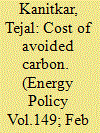

|
|
|
|
|
| Summary/Abstract |
Southern India houses over 49% of the total renewable energy capacity in India. This paper analyses the power supply situation in this region for year 2018 to evaluate the impact of renewable energy policies on energy costs and the resulting cost of avoided carbon. An optimisation model is built using GAMS. Model results show that the cost of absorbing renewable energy due to the “must run” policy for solar and wind energy plants ranges from $1.9/tCO2 to $4.5/tCO2 across states in the region, over and above the carbon tax of $5/tCO2 levied on all electricity consumers in India through the coal cess. ‘Must run’ status implies that the evacuation of power from solar and wind power plants should not be curtailed for factors other than grid or equipment safety. The total additional cost due this policy ranges from $200 to $350 million/year. Inter-regional transfer of renewable energy after meeting the mandated renewable purchase obligations in the region, is suggested as one possible route to reduce the financial burden on distribution utilities. This would reduce the unit cost of energy by about 1–7% across the states. Validating the model results against actual data for the year 2018 suggests that regulatory constraints and policy interventions have reduced the solution space for reasonable cost-based optimisation in Southern India.
|
|
|
|
|
|
|
|
|
|
|
|
|
|
|
|
| 15 |
ID:
177370


|
|
|
|
|
| Summary/Abstract |
Drawing on signaling theory and the greenwashing tendency, the objective of this study is to explore the connection among four facets of corporate social responsibility (CSR) practice: CSR performance, CSR reporting, following the Global Reporting Initiative (GRI) guidelines in preparing CSR reports, and verifying the reliability of CSR reports through an external assurance statement. The sample of the study includes 2244 firm-year observations of energy firms listed in the Thomson Reuters Eikon database for the period 2012–2018. Panel data analysis with fixed effects is used as the empirical methodology. The findings lend support to signaling theory and reject a greenwashing tendency in the energy sector with the validation of hypothesized relationships. More specifically, higher CSR performers show their CSR commitment by issuing CSR reports as well as by adopting GRI guidelines in their CSR reports and verifying the reliability of the contents of their reports through an external assurance statement. Moreover, GRI framework adopters are more likely to obtain external assurance of their reports. The examination of these relationships considering the economic development levels of countries highlights notable differences: all hypothesized connections are stronger for firms established in middle-income countries than for those in high-income countries except for one dimension.
|
|
|
|
|
|
|
|
|
|
|
|
|
|
|
|
| 16 |
ID:
177306


|
|
|
|
|
| Summary/Abstract |
The main objective of this study is to provide a systematic decision support framework based on a holistic simulation approach that allows systematically the technical and economic analysis of a wind power plant (WPP). This model-based spread-sheet consists of various economic and technical indicators, including from the Weibull parameters to the cost of electricity generation. Various scenario-based analyses, namely WPP-1, WPP-2, and WPP-3, with wind turbines with different rated power are conducted for the proposed WPP. In this study, the capacity factor fluctuates from 25.62% to 30.03% while the annual electricity generation is in the range from a minimum of 22.449 MW and a maximum of 26.837 MW. Regarding economic indicators, the Internal Rate of Return (IRR) and the Levelized Cost of Electricity (LCOE) range from 11.7% to 17.38% and from 0.0665 €/kWh to 0.0771 €/kWh, respectively. By discussed and compared both economic and technical indicators, the most feasible scenario selection phase, which is the focal point of the study, is realized to construct and operate the proposed WPP. The developed simulation may be applied to other countries as well and in this way, it helps to be shaped strategic energy policies related to wind energy.
|
|
|
|
|
|
|
|
|
|
|
|
|
|
|
|
| 17 |
ID:
177379
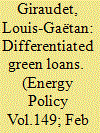

|
|
|
|
|
| Summary/Abstract |
Scaling up home energy retrofits requires that associated loans be priced efficiently. Using a unique dataset of posted loan prices scraped from online simulators made available by French credit institutions, we examine the differentiation of interest rates in relation to project risk. Crucially, our data are immune from sorting bias based on borrower characteristics. We find that greener, arguably less risky, automobile projects carry lower interest rates, but greener home retrofits do not. On the other hand, conventional automobiles carry lower interest rates than do conventional home retrofits, despite arguably similar risk. Our results are robust to a range of robustness checks, including placebo tests. They together suggest that lenders use underlying assets to screen borrower's unobserved willingness to pay, which can cause under-investment in home energy retrofits. We thereby point to a new form of the energy efficiency gap. This has important policy implications in that it can explain low uptake of zero-interest green loan programs.
|
|
|
|
|
|
|
|
|
|
|
|
|
|
|
|
| 18 |
ID:
177305


|
|
|
| 19 |
ID:
177362
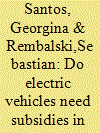

|
|
|
|
|
| Summary/Abstract |
We analyse the total cost of ownership of petrol, diesel, hybrid electric vehicles, plug-in hybrid electric vehicles and battery electric vehicles in the UK over 2017–2029. We do this for large, medium and small cars, under assumptions of 0%, 6%, 30% and 60% discount rates. We find that some electric car models from mass market brands are close to reaching cost parity with their petrol, diesel and hybrid counterparts, but subsidies would accelerate their uptake, especially for impatient consumers with high discount rates. Plug-in hybrid electric vehicles are not worth the effort because, although relatively low, their CO2 emissions are non-zero, and their purchase price is as high or even higher than that of battery electric vehicles. A subsidy of £4,500 or an exemption from the 20% VAT, perhaps capped at £4,500, would accelerate mass market penetration of battery electric vehicles in the UK. If decarbonising road transport were not as urgent as it is, the market for battery electric vehicles could be left to develop on its own, without government intervention. However, because the cost of batteries is not falling fast enough, subsidies are needed in the short term.
|
|
|
|
|
|
|
|
|
|
|
|
|
|
|
|
| 20 |
ID:
177332


|
|
|
|
|
| Summary/Abstract |
Within flow-based market coupling, the EU's preferred method for calculating cross-border trading capacities, recent regulatory changes stipulate minimum trading capacities, so-called minRAMs which have to be provided to electricity markets. Effectively, high predicted flows on considered electricity grid elements have to be reduced to reserve a minimum of the elements' capacities for cross-zonal trading. This analysis investigates if the adjustments made to meet this criterion, in the form of augmented trading domains, lead to higher amounts of curative congestion management. To quantify the effect of increasing minRAMs on overall welfare, the markets and grids of Central Western Europe are analyzed during two representative weeks of 2016. The results show the increasing market coupling welfare is more than offset by rising congestion management costs, leading to net welfare losses. In the best case, the generation plus congestion management costs within Central Western Europe rise by 7.25% when increasing the minRAMs from the current 20%–45% and a minRAM of 70% is 6.28% more expensive compared to a minRAM of 20%. The analysis derives policy recommendations for implementing the minRAM stipulation, with a particular focus on a cost-minimizing selection of generation shift keys, in general as well as situation-dependent terms.
|
|
|
|
|
|
|
|
|
|
|
|
|
|
|
|
|
|
|
|
|